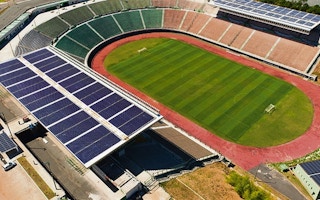From stadiums in Brazil to a bank headquarters in Britain, architects led by Norman Foster are integrating solar cells into the skin of buildings, helping the market for the technology triple within two years.
Sun-powered systems will top the stadia hosting 2014 FIFA World Cup football in Brazil. In Manchester, northern England, the Co-operative Group Ltd. office has cells from Solar Century Holdings Ltd. clad into its vertical surfaces.
The projects mark an effort by designers to adopt building-integrated photovoltaics, or BIPV, where the power-generating features are planned from the start instead of tacked on as an afterthought. Foster and his customers are seeking to produce eye-catching works while meeting a European Union directive that new buildings should produce next to zero emissions after 2020.
“Building integrated solar in office buildings and factories which generate energy consistently during daylight hours, whilst not requiring additional expensive land space or unsightly installations, is seen as the most obvious energy solution,” said Gavin Rezos, principal of Viaticus Capital Ltd., an Australian corporate advisory company that’s one of the private equity funds putting money into the technology.
The market for solar laid onto buildings and into building materials is expected to grow to $7.5 billion by 2015 from about $2.1 billion, according to Accenture Plc, citing research from NanoMarkets. Sales of solar glass are expected to reach as much as $4.2 billion by 2015, with walls integrating solar cells at $830 million. About $1.5 billion is expected to be generated from solar tiles and shingles.
Falling prices
The technology provides a respite for solar manufacturers, opening the way for them to charge a premium for products. Traditional solar panel prices have fallen 90 percent since 2008 due to oversupply, cutting margins and pushing more than 30 companies including Q-Cells SE and a unit of Suntech Power Holdings Co. into bankruptcy.
The industry is already well established in the U.S., where Dow Chemical Co, the country’s largest chemical maker by sales, is selling in more than a dozen states solar shingles that look like regular roofing material.
BASF SE also is developing products for the market. The Santa Clara football stadium near San Francisco will have three solar-array covered bridges, with a solar canopy built over a roof terrace, generating their own power.
“We’re approaching a tipping point and at some point in the future building integrated solar would be a must-have in the design of any new and significant building,” said Mike Russell, managing director of Accenture’s utilities group in London.
Solar stadium
Solar technology has been installed onto the roof of the Pituacu Stadium in Brazil, as well as its locker room and parking canopies, as the nation prepares for the World Cup.
Viaticus has invested in Dyesol Ltd, which makes dyes that mimic how plant leaves turn sunlight into energy. The dyes increase the efficiency of solar cells and provide a product that’s “highly desirable for all buildings, both new and refurbished,” said Rezos.
Dyesol is working with Tata Steel Ltd on ways of incorporating its technology into steel roofing products for industrial warehouses, said Richard Caldwell, its executive chairman. Pilkington Group Ltd., a glass maker, plans to integrate the technology into windows forming the sides of buildings, he said.
VantagePoint of San Bruno, California, and Scottish Equity Partners are backing the efforts of Solar Century Holdings Ltd. in the U.K. to blend solar-generating technology into roof tiles and slates that can be used on homes, offices and architectural buildings. It clad the vertical surfaces of the Co-operative Group’s building in Manchester.
Accessible designs
Incorporating solar into building products does come with its challenges. Foster + Partners, the architectural firm led by Norman Foster that refurbished the Hearst Tower in New York and designed a London skyscraper known as the Gherkin, said it’s important to consider that the structures are accessible for cleaning and maintenance. The company is designing a new London office for Bloomberg LP.
Foster spread 3,156 solar panels across the top of the Masdar Institute building in Abu Dhabi, providing shade for an interior colonnade for the energy research organization.
“While the individual cells are discreet and easy to integrate, they require cabling and additional elements that need to be carefully incorporated,” said David Nelson, head of design at Foster + Partners.
More expensive
Integrated solar products are still at least 10 percent more expensive than traditional solar photovoltaic panels, said Alan South, chief innovation officer at Solar Century.
“At the moment, it’s much cheaper to install a conventional module unless your roof is an unusual shape — and expensive solar installed on unsuitable roofs is a decorative design feature, not an energy solution,” said Jenny Chase, solar analyst at Bloomberg New Energy Finance.
Still, generating electricity where it’s used becomes more attractive as the price of energy from large, central fossil-fuel power stations increases. The cost of solar energy is declining as centrally produced power rises, said Accenture’s Russell. That will weigh on utilities.
“Next-generation solar technologies could have a potentially devastating impact on the utility industry’s revenues,” said Russell. “This will force utilities to spread costs across fewer customers, driving up energy prices, and making distributed generation even more attractive.”

















